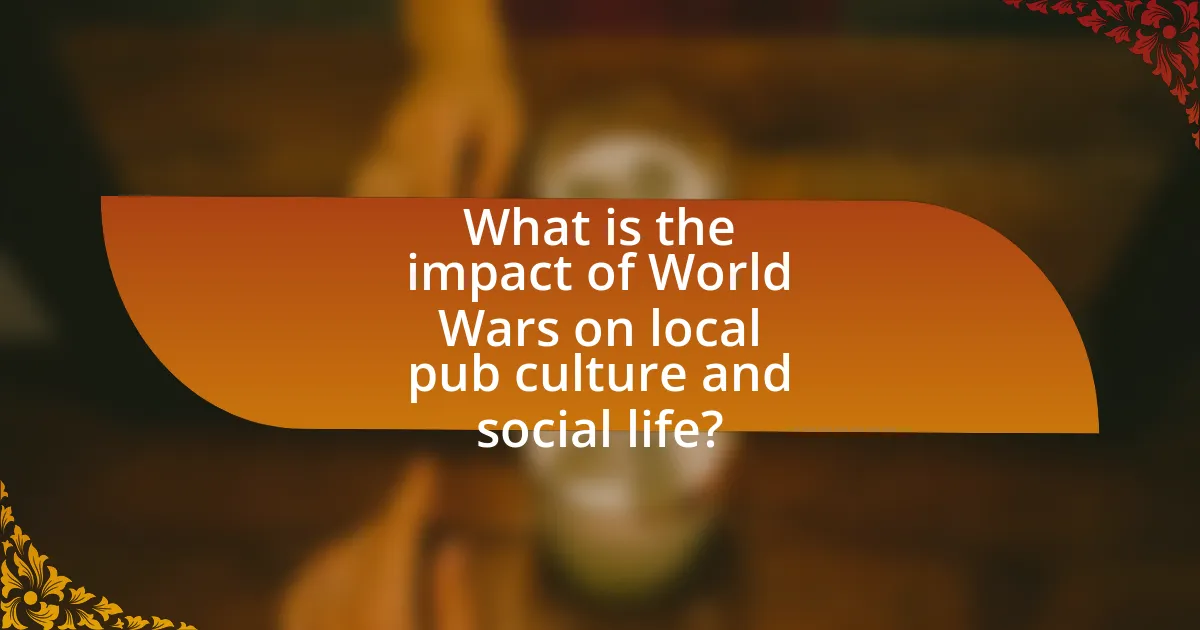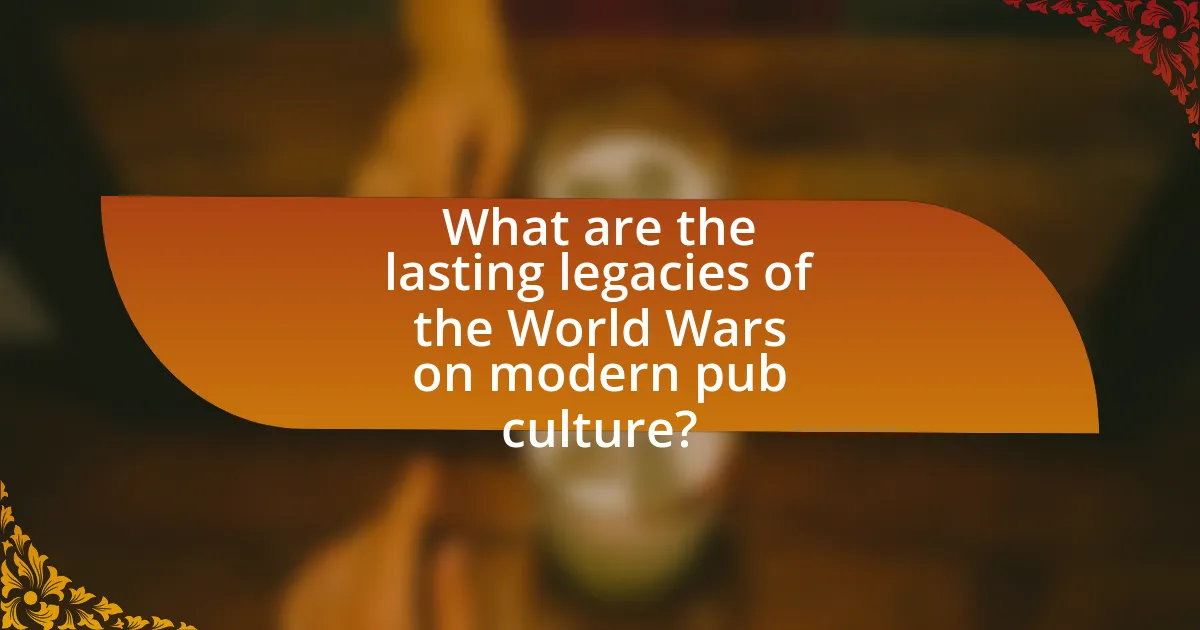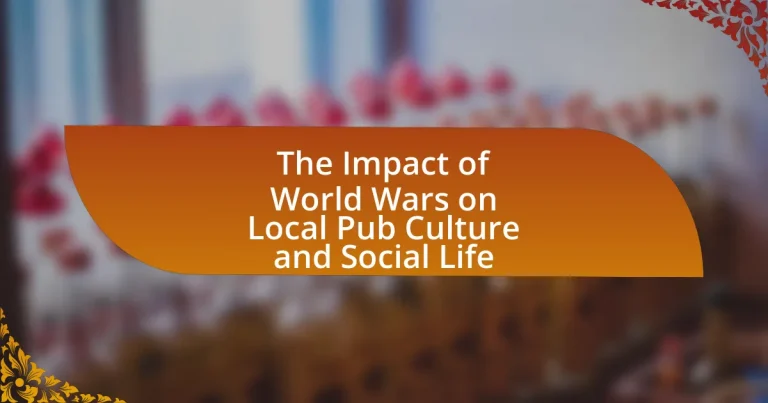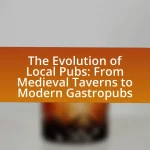The article examines the significant impact of the World Wars on local pub culture and social life, highlighting how these conflicts transformed pubs into essential community hubs. It discusses the changes in social dynamics during and after World War I and World War II, including shifts in patron demographics, the effects of rationing, and the evolution of pub roles as gathering spaces for support and camaraderie. The article also explores long-term changes in pub culture, such as increased inclusivity, the rise of consumerism, and the lasting legacies of wartime experiences reflected in contemporary pub practices and community engagement.

What is the impact of World Wars on local pub culture and social life?
The impact of World Wars on local pub culture and social life was significant, leading to changes in social dynamics and the role of pubs as community hubs. During both World Wars, pubs served as gathering places for soldiers and civilians, fostering a sense of camaraderie and support. For instance, in the UK, the introduction of rationing and wartime restrictions altered the availability of alcohol, which affected pub attendance and operations. Post-war periods saw a resurgence in pub culture as returning soldiers sought social interaction, leading to the establishment of new pubs and the revival of traditional ones. Additionally, the social fabric of communities was transformed, as pubs became venues for discussions about war experiences and rebuilding efforts, thus reinforcing their role in local social life.
How did World War I influence local pubs and social interactions?
World War I significantly influenced local pubs and social interactions by transforming them into vital community hubs for socializing and support. During the war, many men were enlisted, leading to a shift in the demographic of pub patrons, as women began to frequent pubs more regularly, altering traditional social dynamics. Additionally, pubs served as gathering places for returning soldiers, fostering camaraderie and shared experiences among veterans. The war also prompted changes in pub ownership and management, with many establishments adapting to serve the needs of a war-affected community, such as providing a space for fundraising events and social gatherings aimed at supporting the war effort. This evolution of local pubs reflected broader societal changes, as they became essential venues for community bonding and resilience during and after the conflict.
What changes occurred in pub attendance during World War I?
During World War I, pub attendance significantly declined due to various factors. The war led to a reduction in the male population as many men enlisted, resulting in fewer patrons. Additionally, wartime restrictions, such as reduced opening hours and rationing of alcohol, further diminished attendance. For instance, the introduction of the Defence of the Realm Act in 1914 imposed regulations that limited the sale of alcohol, contributing to a notable decrease in pub visits. Consequently, these changes reflected the broader societal impacts of the war on local social life and culture.
How did the role of pubs evolve as community gathering spaces during World War I?
During World War I, the role of pubs evolved significantly as community gathering spaces, transforming from primarily social venues to crucial centers for morale and support. Pubs became places where communities gathered to discuss the war, share news, and support each other through the challenges of wartime. This shift was evidenced by the establishment of fundraising events and social initiatives within pubs, aimed at supporting soldiers and their families. Additionally, the introduction of wartime regulations led to changes in pub hours and offerings, further solidifying their role as essential hubs for community cohesion during a time of uncertainty.
What effects did World War II have on local pub culture?
World War II significantly transformed local pub culture by altering social dynamics and operational practices. During the war, pubs became essential social hubs for communities, providing a space for camaraderie among soldiers and civilians alike. The introduction of rationing affected the availability of alcohol, leading to changes in drink offerings and pricing, which in turn influenced patron behavior. Additionally, the wartime environment fostered a sense of unity and resilience, as pubs often hosted events to support the war effort, such as fundraising activities. This shift in purpose and atmosphere contributed to a lasting legacy in pub culture, where these establishments evolved into vital centers for community engagement and support during and after the war.
How did rationing and shortages affect the pub experience during World War II?
Rationing and shortages significantly diminished the pub experience during World War II by limiting the availability of food and drink. Pubs, traditionally social hubs, faced restrictions on beer production due to the rationing of ingredients like barley and hops, leading to reduced beer strength and variety. Additionally, food shortages meant that many pubs could no longer offer meals, which were essential for attracting patrons. Historical records indicate that the number of pubs in the UK decreased from around 70,000 in 1939 to approximately 50,000 by 1945, reflecting the impact of these shortages on social venues. Consequently, the atmosphere in pubs shifted from vibrant social gatherings to more subdued environments, as patrons dealt with the realities of wartime scarcity.
What role did pubs play in wartime morale and community support during World War II?
Pubs served as vital centers for wartime morale and community support during World War II. They provided a space for social interaction, allowing individuals to gather, share news, and support one another amidst the uncertainties of war. Historical records indicate that pubs organized events such as fundraising activities for troops and hosted community meetings, fostering a sense of unity and resilience. Additionally, the British government recognized the importance of pubs in maintaining morale, leading to initiatives that encouraged their operation despite wartime restrictions. This role was crucial in helping communities cope with the emotional and psychological strains of the war, reinforcing social bonds and collective identity.

How did the aftermath of the World Wars reshape local pub culture?
The aftermath of the World Wars significantly reshaped local pub culture by transforming them into vital community hubs for social interaction and support. Following World War I and World War II, many pubs became places where returning soldiers and local residents gathered to share experiences, fostering a sense of camaraderie and collective healing. The introduction of new licensing laws and the expansion of pub hours in the post-war period also contributed to increased accessibility, allowing more people to frequent these establishments. Additionally, the economic changes and social shifts led to a diversification of pub offerings, including food and entertainment, which catered to a broader demographic. This evolution reflected the changing social landscape, as pubs adapted to serve as venues for community events, discussions, and celebrations, reinforcing their role as central elements of local culture.
What long-term changes in pub culture emerged after World War I?
After World War I, pub culture experienced significant long-term changes, including the rise of the public house as a community hub and the shift towards more inclusive social environments. The war led to a greater emphasis on socializing as a means of coping with loss and trauma, resulting in pubs becoming central places for communal gatherings. Additionally, the introduction of women into the workforce during the war contributed to a gradual acceptance of female patrons in pubs, altering the traditional male-dominated atmosphere. This shift was further supported by legislative changes, such as the Licensing Act of 1921 in the UK, which aimed to modernize and regulate pub operations, promoting a more diverse clientele. These changes collectively transformed pubs into more welcoming spaces for various social interactions, reflecting broader societal shifts in post-war Britain.
How did the social dynamics within pubs shift post-World War I?
Post-World War I, the social dynamics within pubs shifted significantly as they became central hubs for community rebuilding and social interaction. The return of soldiers and the loss of many young men altered the demographic makeup of patrons, leading to a more diverse clientele that included women who had taken on new roles during the war. This change was reflected in the increased acceptance of women in pubs, as they began to frequent these establishments more openly, breaking previous social norms. Additionally, the economic challenges of the post-war period led to a rise in the popularity of public houses as affordable social venues, fostering a sense of camaraderie among patrons who shared similar experiences of loss and change. The introduction of new entertainment forms, such as jazz music and dance, also transformed the atmosphere of pubs, making them vibrant social spaces that encouraged interaction and community bonding.
What new trends in pub design and offerings were introduced after World War I?
After World War I, pubs began to incorporate more modern design elements, such as open-plan layouts and larger windows to create a brighter atmosphere. This shift was influenced by the need for social spaces that could accommodate returning soldiers and a growing working-class population seeking communal experiences. Additionally, the introduction of new beverage offerings, including a wider variety of beers and spirits, reflected changing consumer preferences and the influence of international trends. The establishment of beer gardens and outdoor seating areas also became popular, promoting social interaction in a more relaxed environment. These changes marked a significant evolution in pub culture, aligning with the broader societal shifts of the post-war era.
What transformations occurred in local pubs following World War II?
Local pubs underwent significant transformations following World War II, primarily shifting from traditional male-dominated spaces to more inclusive environments. This change was driven by the social dynamics that emerged post-war, where women increasingly participated in the workforce and sought social spaces. The introduction of new licensing laws in the 1960s further facilitated this transformation by allowing pubs to serve food and operate longer hours, attracting a broader clientele. Additionally, the rise of pub chains and the decline of independent establishments altered the landscape, leading to a more standardized pub experience across the UK. These changes reflect the evolving social fabric of post-war society, where local pubs became central to community life, accommodating diverse groups and fostering social interaction.
How did the rise of consumerism influence pub culture after World War II?
The rise of consumerism after World War II significantly transformed pub culture by shifting the focus from traditional social gatherings to a more commercialized experience. This change was marked by the introduction of a wider variety of beverages, improved pub interiors, and the incorporation of entertainment options such as live music and televised sports, catering to consumer preferences. The 1950s and 1960s saw pubs increasingly marketed as leisure destinations, reflecting the growing disposable income and changing social habits of the post-war population. This shift is evidenced by the increase in the number of licensed establishments, which rose from approximately 60,000 in the early 1950s to over 80,000 by the late 1970s in the UK, indicating a significant expansion of the pub industry aligned with consumerist trends.
What impact did the changing demographics have on local pubs in the post-war era?
The changing demographics in the post-war era significantly impacted local pubs by altering their customer base and social dynamics. As populations shifted due to urbanization, migration, and changes in family structures, pubs began to cater to a more diverse clientele, including younger patrons and women, who previously had less access to these spaces. This demographic shift led to the introduction of new services and amenities, such as family-friendly environments and entertainment options, to attract a broader audience. For instance, the 1950s saw an increase in the number of pubs offering live music and events, reflecting the changing social landscape and the desire for communal spaces that accommodated various social groups.

What are the lasting legacies of the World Wars on modern pub culture?
The lasting legacies of the World Wars on modern pub culture include the establishment of pubs as community hubs and the integration of military themes into pub decor and naming conventions. Following World War I and World War II, many soldiers returned home, leading to a rise in social gatherings at pubs, which became essential spaces for community bonding and remembrance. For instance, the prevalence of war memorials in pubs and the naming of establishments after battles or regiments reflect this connection. Additionally, the post-war era saw the emergence of the “pub quiz” and themed nights, fostering social interaction and camaraderie among patrons, which can be traced back to the communal spirit developed during wartime. These elements illustrate how the World Wars have shaped the role of pubs in fostering social life and community identity.
How do contemporary pubs reflect the historical impact of the World Wars?
Contemporary pubs reflect the historical impact of the World Wars through their architecture, community roles, and cultural significance. Many pubs were established or renovated during the post-war periods, showcasing architectural styles that emerged from the rebuilding efforts after the destruction of the wars. For instance, the use of traditional materials and designs in pubs often pays homage to the craftsmanship that flourished in the aftermath of World War II.
Additionally, pubs serve as communal spaces that foster social connections, a role that became crucial during and after the wars when communities rallied to support returning soldiers and their families. The tradition of the pub as a gathering place for storytelling and remembrance of wartime experiences is evident in many contemporary establishments, which often display memorabilia and host events that honor local history.
Furthermore, the evolution of pub culture, including the rise of craft beers and local sourcing, can be traced back to a desire for community resilience and identity that was strengthened during the wartime periods. This reflects a broader societal shift towards valuing local heritage and community ties, which were essential during the upheaval of the World Wars.
What traditions from the World Wars are still observed in pubs today?
Traditions from the World Wars that are still observed in pubs today include the practice of holding remembrance events and the display of war memorabilia. Pubs often host gatherings on significant dates, such as Remembrance Day, where patrons honor fallen soldiers with moments of silence and the wearing of poppies, a symbol rooted in World War I history. Additionally, many pubs feature photographs, medals, and other artifacts from the wars, serving as a tribute to local veterans and fostering a sense of community remembrance. These practices reflect the enduring impact of the World Wars on social life and local culture, reinforcing connections among patrons through shared history and collective memory.
How do modern pubs serve as memorials or reminders of wartime experiences?
Modern pubs serve as memorials or reminders of wartime experiences by displaying memorabilia, hosting commemorative events, and fostering community discussions about the impact of war. Many pubs feature photographs, plaques, and artifacts that honor local soldiers and significant wartime events, creating a tangible connection to history. For instance, pubs often participate in Remembrance Day activities, where they may hold special gatherings to remember fallen soldiers, thus reinforcing their role as community hubs for reflection and remembrance. This practice not only preserves the memory of wartime experiences but also encourages patrons to engage with their local history, ensuring that the sacrifices made during conflicts are not forgotten.
What lessons can be learned from the impact of the World Wars on local pub culture?
The impact of the World Wars on local pub culture teaches that communal spaces can serve as vital support systems during times of crisis. During both World Wars, pubs became gathering places for communities, fostering social cohesion and providing emotional support to individuals affected by the conflicts. Historical records indicate that in the UK, for instance, pubs offered a sense of normalcy and refuge, with many establishments hosting events to boost morale and raise funds for war efforts. Additionally, the post-war period saw a transformation in pub culture, with an increase in the diversity of clientele and the introduction of new social norms, reflecting broader societal changes. This evolution highlights how external pressures can reshape local culture and community dynamics, emphasizing the resilience of social institutions like pubs in adapting to changing circumstances.
How can current pub owners apply historical insights to enhance social life today?
Current pub owners can apply historical insights from the impact of World Wars on local pub culture to enhance social life today by creating community-focused events that reflect the camaraderie and resilience fostered during those times. For instance, during the World Wars, pubs served as vital social hubs where communities gathered to support each other, share news, and maintain morale. By organizing themed events, such as wartime trivia nights or community remembrance gatherings, pub owners can evoke a sense of nostalgia and unity. Historical data shows that pubs that engage in community-building activities see increased patronage and stronger local ties, as evidenced by studies indicating that social venues promoting community interaction contribute to enhanced social cohesion and well-being.
What best practices can be adopted from the past to foster community in pubs now?
To foster community in pubs now, best practices from the past include hosting regular social events, promoting local music and arts, and creating a welcoming environment for diverse groups. Historical evidence shows that during and after the World Wars, pubs served as vital social hubs where communities gathered to share experiences and support one another. For instance, the British pub culture thrived on community engagement through events like quiz nights and live performances, which encouraged interaction among patrons. Additionally, pubs that embraced local traditions and supported regional breweries not only strengthened community ties but also enhanced the local economy. By adopting these practices, modern pubs can recreate the sense of belonging and camaraderie that characterized pub culture in the past.


